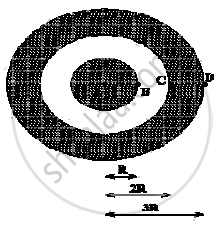Advertisements
Advertisements
प्रश्न
(a) Show that the normal component of electrostatic field has a discontinuity from one side of a charged surface to another given by
`(vec"E"_2 - vec"E"_1).hat"n" = sigma/in_0`
Where `hat"n"` is a unit vector normal to the surface at a point and σ is the surface charge density at that point. (The direction of `hat"n"` is from side 1 to side 2.) Hence show that just outside a conductor, the electric field is σ `hat"n"/in_0`
(b) Show that the tangential component of electrostatic field is continuous from one side of a charged surface to another.
[Hint: For (a), use Gauss’s law. For, (b) use the fact that work done by electrostatic field on a closed loop is zero.]
उत्तर
(a) Electric field on one side of a charged body is E1 and electric field on the other side of the same body is E2. If infinite plane charged body has a uniform thickness, then electric field due to one surface of the charged body is given by,
`vec"E"_1 = -sigma/(2in_0)hat"n"` ..........(1)
Where,
`hat"n"` = Unit vector normal to the surface at a point
σ = Surface charge density at that point
Electric field due to the other surface of the charged body,
`vec"E"_2 = sigma/(2in_0)hat"n"` ........(2)
Electric field at any point due to the two surfaces,
`vec"E"_2 - vec"E"_1 = sigma/(2in_0)hat"n" + sigma/(2in_0)hat"n" = sigma/(in_0)hat"n"`
`(vec"E"_2 - vec"E"_1)hat"n" = sigma/in_0` ......(3)
Since inside a closed conductor, `vec"E"_1` = 0,
∴ `vec"E" = vec"E"_2 = -sigma/(2in_0)hat"n"`
Therefore, the electric field just outside the conductor is `sigma/(in_0)hat"n"`.
(b) When a charged particle is moved from one point to the other on a closed-loop, the work done by the electrostatic field is zero. Hence, the tangential component of the electrostatic field is continuous from one side of a charged surface to the other.
APPEARS IN
संबंधित प्रश्न
A spherical conductor of radius 12 cm has a charge of 1.6 × 10−7 C distributed uniformly on its surface. What is the electric field
- inside the sphere
- just outside the sphere
- at a point 18 cm from the centre of the sphere?
A spherical conducting shell of inner radius r1 and outer radius r2 has a charge Q.
(a) A charge q is placed at the centre of the shell. What is the surface charge density on the inner and outer surfaces of the shell?
(b) Is the electric field inside a cavity (with no charge) zero, even if the shell is not spherical, but has any irregular shape? Explain.
A 4 µF capacitor is charged by a 200 V supply. It is then disconnected from the supply and is connected to another uncharged 2 µF capacitors. How much electrostatic energy of the first capacitor is lost in the form of heat and electromagnetic radiation?
If Coulomb’s law involved 1/r3 dependence (instead of 1/r2), would Gauss’s law be still true?
A 12 pF capacitor is connected to a 50 V battery. How much electrostatic energy is stored in the capacitor? If another capacitor of 6 pF is connected in series with it with the same battery connected across the combination, find the charge stored and potential difference across each capacitor.
Define electrostatic potential at a point. Write its S.I. unit. Three-point charges q1, q2 and q3 are kept respectively at points A, B, and C as shown in the figure, Derive the expression for the electrostatic potential energy of the system.

Fill in the blank.
A point charge is placed at the centre of a hollow conducting sphere of internal radius 'r' and outer radius '2r'. The ratio of the surface charge density of the inner surface to that of the outer surface will be_________.
Electric-field magnitude 'E' at points inside and outside a positively charged spherical conductor having charge Q and a radius R are ______.
If R is the radius of a spherical conductor, Vm the dielectric strength, then the maximum electric-field magnitude to which it can be raised is ______.
The electrostatic force between the metal plates of an isolated parallel plate capacitor C having a charge Q and area A, is ______.
Which of the following statement is true?
Three Charges 2q, -q and -q lie at vertices of a triangle. The value of E and V at centroid of triangle will be ______.
A solid spherical conductor has charge +Q and radius R. It is surrounded by a solid spherical shell with charge -Q, inner radius 2R, and outer radius 3R. Which of the following statements is true?

Consider a finite insulated, uncharged conductor placed near a finite positively charged conductor. The uncharged body must have a potential:
